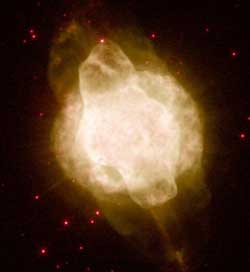Longest atomic state lifetime measured from spontaneous decay in UV

Planetary nebula NGC3918, shown here, is a rare enough environment that atoms refrain from colliding long enough that scientists on Earth can study the spontaneous decay of atoms in very long-lived states. <br>
The internal state of an atom can change by absorbing or emitting bits of light. In a warm gas or plasma the electrons are frequently shuttling back and forth from one state to another. Some of these states are longer lived than others, though, because of extenuating circumstances. For instance, many transitions from an excited state to the ground state occur in nanoseconds, but some can last for tens of seconds or longer. Measuring the true lifetime of the longer-lived of these transitions is difficult for the simple reason that ev en when a sample of atoms is dilute, an atom is being bumped so often that de-excitations come about before the state decays radiatively.
When even the best laboratory vacuum on Earth is still too crowded for making such delicate measurements, persistent scientists turn to outer space. Tomas Brage of Lund University (Lund, Sweden), Philip Judge of the High Altitude Observatory at NCAR (Boulder, CO), and Charles Proffitt of the Computer Science Corporation (Baltimore, MD) resort to viewing excited atoms in the planetary nebula NGC3 918 where, amid the wreckage of a dying star, there is enough energy to excite a toms but a density low enough (a few 1000 per cubic centimeter) that mutual pumping isn’t a problem (see image). Using the Hubble Space Telescope, the three scientists looked at the emissions of excited triply ionized nitrogen atoms and observed a lifetime of 2500 seconds for one particular hyperfine transition. Why is this state so robust?
Brage (tomas.brage@fysik.lu.se, 46-46-222-7724) says that angular momentum can be preserved in this transition only if, in addition to the electron emitting an ultraviolet photon, the nucleus itself flips over. Other than adding to basic knowledge about atomic physics , studies like these should provide spectroscopic information for studying the deaths of stars. (Brage et al., upcoming article in Physical Review Letters, probably 16 December; text at www.aip.org/physnews/select)
Media Contact
More Information:
http://www.aip.org/physnews/selectAll latest news from the category: Physics and Astronomy
This area deals with the fundamental laws and building blocks of nature and how they interact, the properties and the behavior of matter, and research into space and time and their structures.
innovations-report provides in-depth reports and articles on subjects such as astrophysics, laser technologies, nuclear, quantum, particle and solid-state physics, nanotechnologies, planetary research and findings (Mars, Venus) and developments related to the Hubble Telescope.
Newest articles

First-of-its-kind study uses remote sensing to monitor plastic debris in rivers and lakes
Remote sensing creates a cost-effective solution to monitoring plastic pollution. A first-of-its-kind study from researchers at the University of Minnesota Twin Cities shows how remote sensing can help monitor and…

Laser-based artificial neuron mimics nerve cell functions at lightning speed
With a processing speed a billion times faster than nature, chip-based laser neuron could help advance AI tasks such as pattern recognition and sequence prediction. Researchers have developed a laser-based…

Optimising the processing of plastic waste
Just one look in the yellow bin reveals a colourful jumble of different types of plastic. However, the purer and more uniform plastic waste is, the easier it is to…


